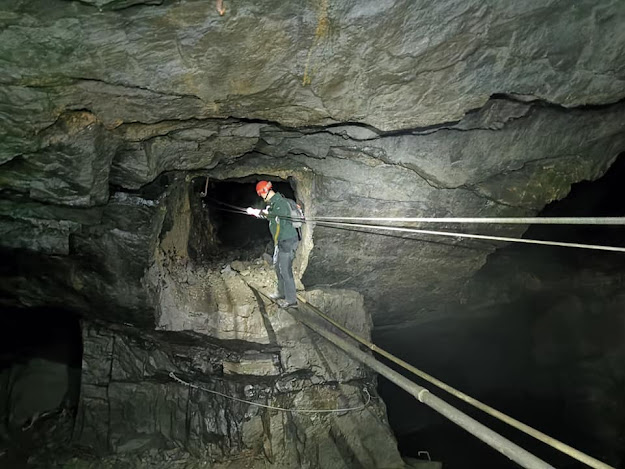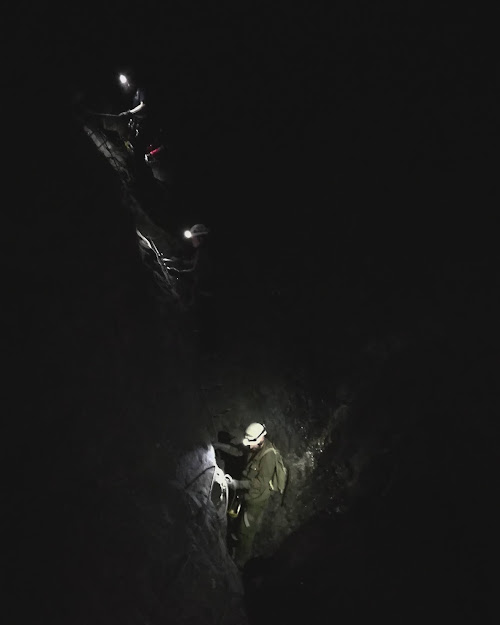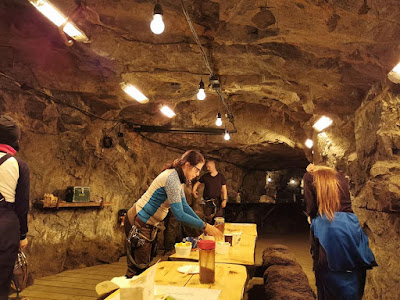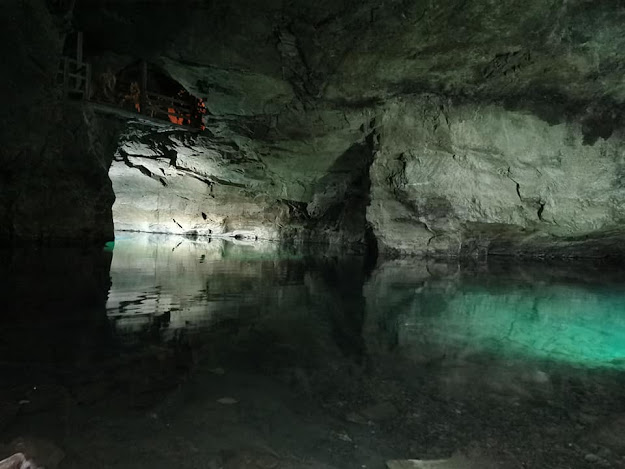Sounds dramatic, huh?
But no Balrogs were awakened, nor goblins encountered.
Well, those who know me, know that I am not overly fond of caves or mines (to little dwarf-genes, I suppose) and that I like tight spaces even less! No, I am not afraid of the dark and yes, I am slightly claustrophobic.
Despite this my outdoor buddy Olli gave me a call, inviting me to join a guided tour through the former iron mines of Tuna-Hästberg, near the city of Borlänge. Something I accepted gladly, although somewhat reluctantly too. But I felt the need to socially interact and to do something. Get out.
So I picked him up and we were to meet a Dutch couple on our way to the mine. Him, Niels, I had met before, last year on a hike and now he had brought along his girlfriend on a 1,5 year tour through Europe. Ah, the joys of youth and an adventurous mind... Anyway....
I can be pretty brief about the mine. It is a mine laid to rest in the late 60's and is actually pretty boring. Mostly dark grey stone, as apparently is usual for an iron ore mine. With copper, like in Falun, the geological scenery tends to be more colourful.
Very interesting fact about today's use, though, is that the mine is famous for it cavediving characteristics. In fact world famous. You can get down to 80 meters, as we did, without getting wet feet, but lower than that, and this mine goes to 220 meters, you need diving equipment. Its linked neighbour mine goes even down to below 800.
The mine itself has several horizontal levels at 20, 40 and 80 meters depth, yet all the shafts are at an 45 degree angle and there is no pattern to them really. Pop up here, there and everywhere, so we had to secure ourselves to a steel line and remain that throughout the tour. Those shafts at times did appear right next to us and our feet!

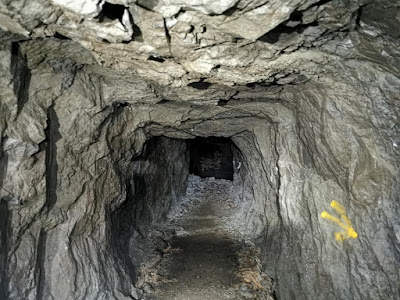


Both Olli and I tried to find signs of life down here. In winter these mines are used by hibernating bats, but none were there now. No sign of algae or mosses either. At one point we discovered a network of mycorrhiza (rootsystem of fungi), spread out over the floor. At the center were the remains of wood, so we figure it came down with the wood, consumed it and spread out afterward.
Rockwise we did come across a more colourful wall, but that was pretty much the only interesting wall I saw and I brought some smaller pieces of rock with me.


But no Balrogs were awakened, nor goblins encountered.
Well, those who know me, know that I am not overly fond of caves or mines (to little dwarf-genes, I suppose) and that I like tight spaces even less! No, I am not afraid of the dark and yes, I am slightly claustrophobic.
Despite this my outdoor buddy Olli gave me a call, inviting me to join a guided tour through the former iron mines of Tuna-Hästberg, near the city of Borlänge. Something I accepted gladly, although somewhat reluctantly too. But I felt the need to socially interact and to do something. Get out.
So I picked him up and we were to meet a Dutch couple on our way to the mine. Him, Niels, I had met before, last year on a hike and now he had brought along his girlfriend on a 1,5 year tour through Europe. Ah, the joys of youth and an adventurous mind... Anyway....
I can be pretty brief about the mine. It is a mine laid to rest in the late 60's and is actually pretty boring. Mostly dark grey stone, as apparently is usual for an iron ore mine. With copper, like in Falun, the geological scenery tends to be more colourful.
Very interesting fact about today's use, though, is that the mine is famous for it cavediving characteristics. In fact world famous. You can get down to 80 meters, as we did, without getting wet feet, but lower than that, and this mine goes to 220 meters, you need diving equipment. Its linked neighbour mine goes even down to below 800.
The mine itself has several horizontal levels at 20, 40 and 80 meters depth, yet all the shafts are at an 45 degree angle and there is no pattern to them really. Pop up here, there and everywhere, so we had to secure ourselves to a steel line and remain that throughout the tour. Those shafts at times did appear right next to us and our feet!




Both Olli and I tried to find signs of life down here. In winter these mines are used by hibernating bats, but none were there now. No sign of algae or mosses either. At one point we discovered a network of mycorrhiza (rootsystem of fungi), spread out over the floor. At the center were the remains of wood, so we figure it came down with the wood, consumed it and spread out afterward.
Rockwise we did come across a more colourful wall, but that was pretty much the only interesting wall I saw and I brought some smaller pieces of rock with me.



